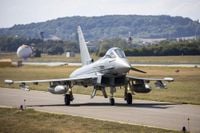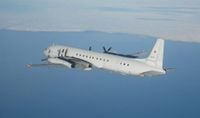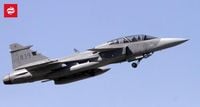On Sunday, September 21, 2025, the skies above the Baltic Sea became the stage for a tense but meticulously coordinated military response, as both German and Swedish air forces scrambled fighter jets to intercept a Russian reconnaissance aircraft flying unannounced in international airspace. The incident, which concluded without confrontation, is the latest in a series of aerial encounters that have heightened security concerns across northern Europe.
According to multiple sources, including the Associated Press and Handelsblatt, the episode began when radar operators detected a Russian IL-20M—known by its NATO reporting name “Coot-A”—operating over the southern Baltic Sea. The aircraft, a relic of the Cold War era but still a critical asset in Russia’s signals intelligence arsenal, was flying without a filed flight plan and had not established radio contact with civilian or military air traffic controllers. Its transponders, which would normally broadcast its identity and position, were switched off, rendering it effectively invisible to routine air traffic management.
Germany’s Luftwaffe was the first to respond, dispatching two Eurofighter Typhoon jets from its quick reaction alert force based at Rostock-Laage airfield. “Once again, our quick reaction alert force, consisting of two Eurofighters, was tasked by NATO with investigating an unidentified aircraft without a flight plan or radio contact in international airspace,” the German air force said in a statement quoted by Handelsblatt. After visually identifying the aircraft as a Russian IL-20M, the German pilots handed off the monitoring mission to two Swedish JAS 39 Gripen fighters, which had been scrambled in parallel from bases in Sweden.
The Swedish air force confirmed their involvement, posting on X: “Today, JAS 39 Gripens and German Eurofighters were scrambled over the South Baltic Sea, identifying and monitoring a Russian IL-20 reconnaissance aircraft in international airspace.” A photo released by the Swedish military showed the Russian plane flanked by NATO fighters, a stark visual reminder of the region’s heightened alert status.
The interception itself unfolded entirely in international airspace, and according to both German and Swedish officials, the operation ended without incident. After the handover, the German jets returned to their base at Rostock-Laage, while the Swedish Gripens continued to shadow the Russian aircraft until it departed the area. The Russian IL-20M, with its distinctive array of sensors and antennae, is designed for electronic intelligence gathering—snooping on communications, radar emissions, and other signals of military value.
This latest incident did not occur in isolation. It came just two days after another alarming breach: on September 19, three Russian fighter jets entered Estonia’s airspace without authorization, remaining for approximately 12 minutes. The Estonian Foreign Ministry swiftly condemned the violation, and, for the first time in its history, Estonia requested an emergency meeting of the United Nations Security Council, scheduled for September 22. “For the first time in its history, the country has requested such an event after Russian fighter jets violated its airspace on the 19th,” reported Liga.net.
Heightened vigilance is becoming the norm across NATO’s northeastern flank. The week prior, NATO aircraft had downed Russian drones over Poland, stoking fears that the ongoing war in Ukraine could spill into alliance territory. In response, the United Kingdom sent Royal Air Force Typhoon jets to patrol Polish airspace for the first time as part of NATO’s “Eastern Sentry” mission, flying close to the borders with Belarus and Russia. “Nothing significant was reported from the UK’s first Nato ‘Eastern Sentry’ operation,” noted The Independent, but the message was clear: the alliance is on high alert.
Further underscoring the sense of urgency, September 22 also saw the launch of the first-ever joint military exercises between Poland and Sweden in the Baltic Sea, a move widely interpreted as a show of unity and readiness among NATO partners. “On the same day, started the first ever joint military exercises of Poland and Sweden in the Baltic Sea,” Liga.net reported, highlighting the growing cooperation among regional powers.
The Russian IL-20M, which entered service in the late 1960s, is a workhorse of Moscow’s intelligence-gathering fleet. Developed from the civilian Ilyushin IL-18 turboprop airliner, it’s equipped with side-looking radar, optical and infrared sensors, and an array of antennae for scooping up electronic signals. Its flights near NATO borders are not uncommon, but when they occur without proper notification or with transponders switched off, they are seen as provocative and potentially dangerous.
“The aircraft had been flying without providing a flight path or establishing radio contact,” Swedish and German officials confirmed to the Associated Press. Such behavior increases the risk of mid-air collisions—not only with military jets but also with civilian airliners traversing some of Europe’s busiest corridors. For this reason, NATO maintains a network of quick reaction alert forces, ready to intercept and identify unidentified aircraft at a moment’s notice.
Earlier in the year, German Eurofighters from Laage had intercepted another Russian IL-20M that entered NATO airspace near the German island of Rügen, again without an active transponder or flight plan. On that occasion, the German pilots escorted the aircraft back toward Russian territory in Kaliningrad, a heavily militarized enclave wedged between Poland and Lithuania.
The frequency of such encounters has increased since Russia’s full-scale invasion of Ukraine in 2022, with NATO and EU member states reporting regular incursions and surveillance flights along their borders. These episodes are not merely routine military maneuvers; they are part of a broader contest for intelligence, influence, and deterrence in a region where the margin for error is perilously thin.
While the September 21 interception ended peacefully, the cumulative effect of these incidents is to raise the stakes for all involved. Each scramble, each shadowed flight, is a reminder of how quickly misunderstandings or technical mishaps could escalate into something far more serious. As NATO partners tighten their coordination and Russia continues its intelligence-gathering missions, the Baltic skies remain a theater of both vigilance and vulnerability.
With Estonia’s unprecedented appeal to the United Nations and new military exercises underway, the Baltic region is sending a clear signal: the days of complacency are over. For now, the balance holds—but the watch continues, as every blip on the radar could herald the next test of resolve and readiness.






